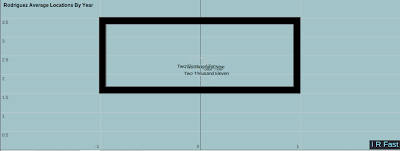Rodriguez has been one of the top velocity fastball pitchers in the entire Pitch F/X era, which makes his struggles so interesting. According to average velocity by the MLBAM tags, he has steadily lost velocity, and it seems that he has had a statistical decline to go with it. However, when you look at the velocity of his top 25% pitches by year, the decline is less dramatic.
2013: 99.28 MPH
2012: 99.26 MPH
2011: 99.43 MPH
2010: 100.37 MPH
2009: 100.03 MPH
So really he didn't lose top end velocity in any way that should really have changed anything. The average of all pitches thrown in the Majors was 94.57 MPH, let's see how his how his velocity and release point data breaks down with results for his career:
Whiffs: 93.56 MPH, 6.27 v,-1.14 h
Run Scoring Plays: 95.01, 6.27 v, -1.24 h
Outs: 96.12, 6.25 v ,-1.19 h
In Play, No Outs: 94.64 MPH, 6.28 v, -1.19 h
Not surprisingly, the closer to the center of the rubber he releases the ball, the better the result (though it didn't affect the results BABIP plays). The velocity is a little more complicated, as the hardest group is the one that is turned into outs, and the softest group is the whiffs. The ones in between were the hits and runs. Perhaps his fastest fastballs are turned into outs, while his slider and change are getting whiffs. Vertical movement didn't have a real difference.
The average vertical movement of his 4-seam fastball is 9.13, which is good movement, and even better than the average whiff on a plus fastball this season. Movement is clearly not the problem.
Here are his average locations by pitch type:
That is a good place to put a moving fastball, and the change and slider are in somewhat standard spots, though perhaps lower and less to the edge of the plate than usual, suggesting that he is burying them and not really throwing them for strikes often. His 4-seamer being glove side on average and not arm side is unusual. This means he clearly isn't having a problem finishing his delivery, but may be pulling the ball.
His average locations by result:
Even though release point data suggests that he is releasing the ball at a higher point than when he first came up, he hasn't really changed pitching location by year, other than his 2011 season, probably not coincidentally his best season, is the lowest
Rodriguez' problems don't seem to be the traditional answers like "too many balls up" or that his fastball was "too straight". Instead, as his walk rates suggests, he may just not be throwing enough strikes.
He threw strikes just 58% of the time in 2012 and 58.9 % of the time for his career, which is Carlos Marmolian territory. With that said, he pitches in the zone 43.2 % of the time, which is better than notable relievers Huston Street, Scott Downs, along with notable starters Gio Gonzalez, Jeremy Hellickson, and Jarrod Parker. So the zone percentage is actually acceptable, but his strike percentage lags behind, suggesting he isn't getting swings and misses out of the zone to make up for the zone percentage. The other 11 pitchers that have his identical outside the zone swing percentage (according to Fangraphs, with at least 100 innings since Rodriguez' debut) have an average zone percentage of 45.63 %, suggesting that Rodriguez isn't living with the amount of pitches he throws in the zone because he isn't getting the swings at pitches out of the zone. This suggests that his stuff either a) his stuff (especially his breaking balls) isn't good enough to get hitters to chase or b) when he is out of the zone, he is so far out of the zone that hitters aren't tempted to chase. Both of these are hard to test, but the first one seems unlikely since he has a good swinging strike percentage.
The problem probably isn't that Rodriguez throws such a heavy dosage of fastballs, as there have been some successful closers with an even higher percentage of fastballs (such as Valverde, Perez, Balfour, Feliz, Chapman, and Walden). With his velocity, that shouldn't be a problem unless his release point is just easy to see, which anecdotally doesn't seem to be the case, though when he comes further out, he is less likely to succeed. According to Brooks Baseball his slider gets above average horizontal movement and below average vertical movement. His change gets slightly above average horizontal movement and slightly better vertical movement, yet it is his slider that seems to be the better pitch.
Perhaps when Rodriguez misses out of the zone, it is just too much out of the zone. While wild pitches can be a subjective stat, often just in the hands of the official scorer, Rodriguez throws a wild pitch .055 times per batter faced. League average in 2012 was .008, which means that Rodriguez, in his time in the Majors, has thrown nearly 31 more wild pitches than an average pitcher would. This matches up with what I (and probably most Nationals' fans) have seen when watching Rodriguez. He sometimes self destructs and can't get anything close to the zone, which I think explains, even with his stuff, why he can't get swings at pitches out of the zone, and therefore, can't get hitters out at an exceptional or even average rate in the Majors despite his exceptional velocity. I would always take chances on guys like this, and it might not be a bad idea for a team to claim him and see if they can pitch him in low leverage situations and tweak or overhaul his mechanics, because if he ever does get around the zone, he should be really good.



No comments:
Post a Comment